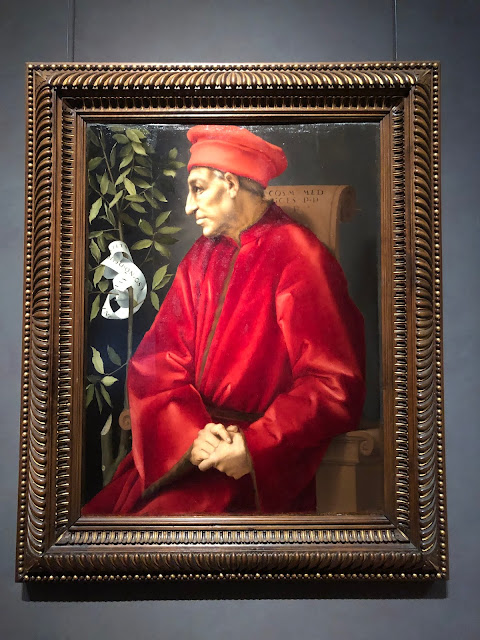【フィレンツェ】ウフィツィ美術館 ポントルモとロッソ・フィオレンティーノ Firenze - Gallarie degli Uffizi : Pontormo & Rosso Fiorentino
ウフィッツィ美術館の3階フロアから2階に降りてきた。
3階には、ボッティチェッリやダ・ヴィンチ、ミケランジェロやラファエロなどの超有名な画家たちの作品があり、多くの人にとっては、2階は帰り道の一部ということらしい。
多くの人が、時間を気にするように足早に各部屋を駆け抜けていく。
しかし、このフロアにも、マニエリスムの画家たちや、カラヴァッジョなど、素晴らしい画家たちの作品が展示されている。
まずは、マニエリスムの画家たちから見ていこう。
ヤコポ・ダ・ポントルモは、1494年にエンポリ近郊のポントルメという町で生まれた。
幼い頃に孤児になったポントルモは、フィレンツェに出て、アンドレア・デル・サルトの元で絵を学んだ。
この絵は、1525年に描かれた『エマオの晩餐』で、当時、ポントルモはアルブレヒト・デューラーの影響を受けていたという。
I came down from the 3rd floor of the Uffizi Gallery to the 2nd floor.
On the 3rd floor, there are works by super-famous painters such as Botticelli, Da Vinci, Michelangelo and Raphael, and for many, the 2nd floor seems to be part of the way home.
Many people rush through each room as if they care about time.
However, the works of Mannerist painters and great painters such as Caravaggio are also exhibited on this floor.
Let's start with the Mannerist painters.
Jacopo da Pontormo was born in 1494 in the town of Pontorme near Empori.
Pontormo, who became an orphan when he was young, went to Florence to study painting under Andrea del Sarto.
This painting is "Supper at Emmao" drawn in 1525, and it is said that Pontormo was influenced by Albrecht Durer at that time.
画家として独り立ちした後は、主にメディチ家からの注文を受けて、多くの作品を描いた。
ポントルモの筆による、コジモ・デ・メディチの肖像画は、そのことをよく表している。
この作品は、1519年から1520年に描かれた作品で、ウルビーノ公ロレンツォ・デ・メディチの注文で描かれた。しかし、ロレンツォは1519年に亡くなっている。
After becoming independent as a painter, he drew many works, mainly in response to orders from the Medici family.
The portrait of Cosimo de'Medici, written by Pontormo, illustrates this well.
This work was painted from 1519 to 1520 and was ordered by Lorenzo de'Medici, Duchy of Urbino. However, Lorenzo died in 1519.
ポントルモの『マリア・サルヴィアティの肖像』。
マリア・サルヴィアティは豪華王ロレンツォ・デ・メディチの孫娘で、後にトスカーナ大公となるコジモ1世を産んだ。
この絵の描かれた年は、1545年とも1550年とも言われているが、いずれもコジモ1世がトスカーナ大公になってから描かれている。
しかし、この陰鬱なイメージの肖像画からは、フレンツェを支配する大公の母親、という華やかな雰囲気は感じられない。
Pontormo's "Portrait of Maria Salviati".
Maria Salviati was the granddaughter of the gorgeous King Lorenzo de'Medici and gave birth to Cosimo I, who later became Grand Duchy of Tuscany.
The year in which this painting was drawn is said to be 1545 and 1550, both of which were drawn after Cosimo I became Grand Duchy of Tuscany.
However, the portrait of this gloomy image does not give the glamorous atmosphere of the mother of the Grand Duke who controls Frenze.
ロッソ・フィオレンティーノは、1495年にフィレンツェで生まれ、ポントルモと同様に、アンドレア・デル・サルトの元で絵を学んだ。
ポントルモとは違って、ロッソ・フィオレンティーノは、その後フィレンツェを離れて、ローマやヴェネツィアで活動した。
ポントルモもロッソ・フィオレンティーノも、いわゆるマニエリスムの画家たちは、ミケランジェロの絵画に大きな影響を受けている。
この『ジェスロの娘を守るモーセ』という作品を見ると、明らかにミケランジェロの肉体表現を参考にしているのがよくわかる。
Rosso Fiorentino was born in Florence in 1495 and, like Pontormo, studied painting under Andrea del Sarto.
Unlike Pontormo, Rosso Fiorentino then left Florence to work in Rome and Venice.
Both Pontormo and Rosso Fiorentino, the so-called Mannerist painters, were greatly influenced by Michelangelo's paintings.
Looking at this work "Moses Protecting Jessro's Daughter", it is clear that Michelangelo's physical expression is used as a reference.
この『スペダリンゴの聖母』は、1518年に描かれたが、ヴァザーリが『芸術家列伝』の中で、幼児イエスの表情が悪魔のようだ、として受け取りを拒否されたというエピソードを紹介している。
確かのその表情をよく見ると、歌舞伎の隈取のように目の周りが黒く塗られていて、不気味な表情に見える。
This "Virgin of Spedalingo" was drawn in 1518, but Vasari tells an episode in "Artist Retsuden" that the expression of the infant Jesus was rejected because it looked like a devil. ..
If you look closely at that expression, the area around your eyes is painted black like Kabuki's Kumadori, and it looks like an eerie expression.
『入浴する二人の女』というこの絵は、典型的なフォンテーヌブロー派の作品。
ロッソ・フィオレンティーノは、1530年にフランスのフランソワ1世に招かれてフランスに移り、その地で生涯を終えた。
フランスでは、フォンテーヌブロー城の改築などにも関わり、そこにフランソワ1世の生涯についての壁画を描いた。
1519年にフランスで亡くなったレオナルド・ダ・ヴィンチと合わせて、ロッソ・フィオレンティーノらのイタリアの芸術家たちの影響によって、フランスにはフォンテーヌブロー派という流派が生まれた。
しかし、この絵を見ると、ロッソ・フィオレンティーノの作品というより、その濃厚な色使いは、ブロンジィーノの影響の方が強いように感じられる。
This painting, "Two Women Bathing," is a typical Fontainebleau work.
Rosso Fiorentino was invited by Francis I of France in 1530 to move to France, where he ended his life.
In France, he was involved in the reconstruction of Fontainebleau Castle, where he painted murals about the life of Francis I.
Together with Leonardo da Vinci, who died in France in 1519, the influence of Italian artists such as Rosso Fiorentino created the School of Fontainebleau in France.
However, looking at this painting, it seems that Bronzino's influence is stronger than Rosso Fiorentino's work in its rich color scheme.








コメント
コメントを投稿